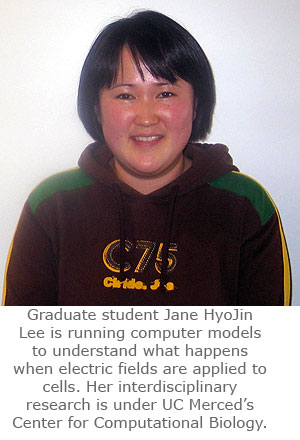

UC Merced
graduatestudent Jane HyoJin Lee is studying what happens to cells when they’re exposed to an electric field, part of an effort to create more treatments for diseases such as cancer.
Her research, in conjunction with a graduate student and a professor at University of Southern California, is sponsored by UC Merced’s
Center for Computational Biology. The interdisciplinary center uses computer models to expand biological understanding and is an example of the university’s commitment to addressing some of society’s pressing problems. The center also funds research that involves optical measurements with lasers and modeling biological networks.
Electricity causes cell membranes to open so they can better absorb chemicals, said Lee, who’s pursuing her Ph.D. in
applied mathematics.
Lee, a research assistant for Assistant Professor
Mayya Tokman, started on the project in the beginning of 2009. They run computer models and analyze the results to see how the technology can be used for the treatment of diseases. Lee is planning to use the research as the basis for her dissertation.
The energy opens up the membrane so the cell is more receptive to drugs, Tokman explained. Electricity can also be used to jolt diseased cells into destroying themselves so they don’t continue to reproduce. Patented electrical treatments are being tested to fight skin cancer, Tokman noted.
It’s a powerful technique, she said. We’re still learning a lot.
The team in Southern California runs tests on cell samples and also does some computer simulations. The focus of Tokman and Lee’s research is modeling the different ways cells will respond to electricity and to learn more about why cells react the way they do.
Originally from Korea, Lee did her undergraduate work in applied math and physics at the University of Auckland in New Zealand. She met Tokman at a conference, a connection that led her to UC Merced. She said she’s been rapidly expanding her biological knowledge and can easily get questions answered by professors when she’s stuck on something.
Using her applied math in biology has been rewarding because it’s more hands-on, Lee said.
So far, I love it, Lee said. It’s very exciting. It’s a great opportunity to work on real-life application.
Lee will be presenting a poster about the research in February at the Biophysical Society’s annual meeting in San Francisco.






